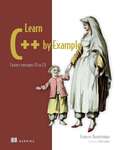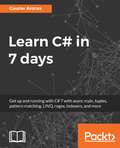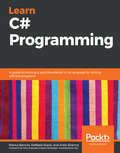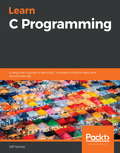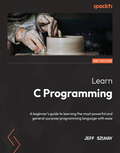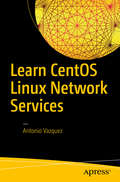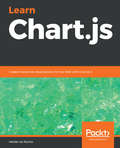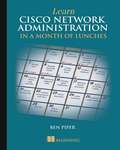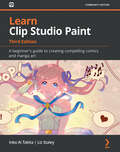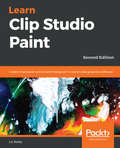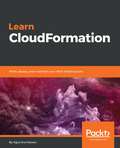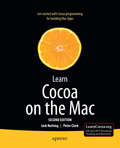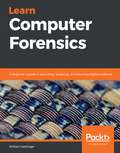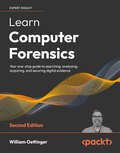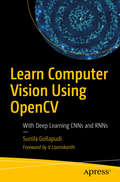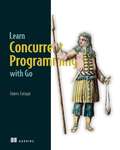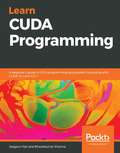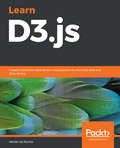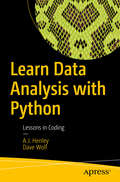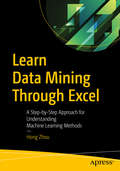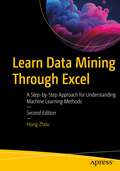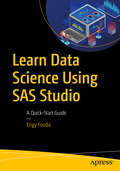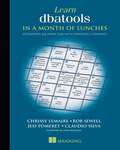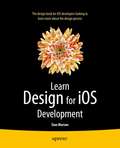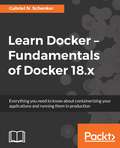- Table View
- List View
Learn C++ by Example: Covers versions 11 to 23 (Bookcamp Ser.)
by Frances BuontempoLearn the latest features of modern C++ by coding eight engaging projects.Don&’t let the multitude of C++ updates intimidate you! Learn C++ by Example takes you through the major language changes since C++ 11, with each new feature demonstrated with a fun project or minigame. It&’s perfect for beginners who know C++ basics, coders coming back to the language, or current C++ developers missing out on everything the language has to offer. Inside Learn C++ by Example you&’ll find important skills such as: Utilizing the new C++ features from C++ 11 to 23 Effectively testing your C++ code What happens &“under the hood&” of C++ code Picking efficient algorithms and data structures std::format, STL algorithms, ranges, and coroutines Learn C++ by Example rapidly gets up to speed with C++&’s updates and changes, and ensures you&’ll stay ahead as the language continues to change and grow. You&’ll learn about vectors and ranges by generating Pascal&’s triangle, create a racing game with new special member functions, build a slot machine with parameter packs, and more. Foreword by Matt Godbolt. About the technology C++ delivers the flexibility and performance you need for everything from low-level systems programming to secure financial applications and AAA game development. First introduced in 1985, the language is still evolving, with exciting changes in every new version. Whether you&’re just getting started or you&’re a veteran coder adding to your toolbox, the eight hands-on projects in this book will get you up to speed on modern C++ features and practices. About the book Learn C++ by Example is a fun and practical way to start writing modern C++ code. It guides you through entertaining challenges, emphasizing features and techniques made possible by C++ 17, 20, and 23. You&’ll learn about objects and arrays by creating a deck of playing cards, master the C++ random library for a number guess game, use the chrono library to create a countdown timer, and much more. Along the way you&’ll also pick up valuable tips for testing, project organization, and other productivity skills. What's inside New C++ features from C++ 11 to 23 Effectively test your C++ code What happens &“under the hood&” Efficient algorithms and data structures About the reader Requires beginner to intermediate C++ skills. About the author Frances Buontempo is an experienced C++ developer and the editor of ACCU&’s Overload magazine. The technical editor on this book was Timothy Jaap van Deurzen. Table of Contents 1 Hello again, C++! 2 Containers, iterators, and ranges 3 Input of strings and numbers 4 Time points, duration, and literals 5 Creating and using objects and arrays 6 Smart pointers and polymorphism 7 Associative containers and files 8 Unordered maps and coroutines 9 Parameter packs and std::visit
Learn C# in 7 days
by Gaurav AroraaLearn C# in 7 days with practical examples, build a foundation for C# programming, and boost your skills to an advanced level About This Book • Learn the basics of C# in 7 days • Works as a reference guide describing the major features of C# • Build easy and simple code through real-world example scenarios Who This Book Is For The book is for aspiring developers and absolute novices who want to get started with the world of programming. You do not need any knowledge of C# for this book. What You Will Learn • Understand and set up the .NET environment • Code in C# using the Visual Studio 2017 RC (preferable community edition) IDE • Define variables, syntax, control flows, statements, and arrays etc through examples • Understand the concepts of Object-Oriented Programming using C# • Get acquainted with attributes, collection, generics, and LINQ • Get your hands on class members such as Modifiers, Methods, Properties, Indexers, File I/O, Exception Handling, and Regex • Build a real-world application using C# 7 In Detail This book takes a unique approach to teach C# to absolute beginners. You'll learn the basics of the language in seven days. It takes a practical approach to explain the important concepts that build the foundation of the C# programming language. The book begins by teaching you the basic fundamentals using real-world practical examples and gets you acquainted with C# programming. We cover some important features and nuances of the language in a hands-on way, helping you grasp the concepts in a fluid manner. Later, you'll explore the concepts of Object-Oriented Programming (OOP) through a real-world example. Then we dive into advanced-level concepts such as generics and collections, and you'll get acquainted with objects and LINQ. Towards the end, you'll build an application that covers all the concepts explained in the book. By the end of this book, you will have next-level skills and a good knowledge of the fundamentals of C#. Style and approach Fast paced guide to get you up-to-speed with the language. Every chapter is followed by an exercise that focuses on building something with the language. The codes of the exercises can be found on the Packt website
Learn C# Programming: A guide to building a solid foundation in C# language for writing efficient programs
by Marius Bancila Raffaele Rialdi Ankit Sharma Dino EspositoGet started with C# and strengthen your knowledge of core programming concepts such as procedural, object-oriented, generic, functional, and asynchronous programming along with the latest features of C# 8 Key Features Learn the fundamentals of C# with the help of easy-to-follow examples and explanations Leverage the latest features of C# 8, including nullable reference types, pattern matching enhancements, and asynchronous streams Explore object-oriented programming, functional programming, and multithreading concepts Book Description The C# programming language is often developers' primary choice for creating a wide range of applications for desktop, cloud, and mobile. In nearly two decades of its existence, C# has evolved from a general-purpose, object-oriented language to a multi-paradigm language with impressive features. This book will take you through C# from the ground up in a step-by-step manner. You'll start with the building blocks of C#, which include basic data types, variables, strings, arrays, operators, control statements, and loops. Once comfortable with the basics, you'll then progress to learning object-oriented programming concepts such as classes and structures, objects, interfaces, and abstraction. Generics, functional programming, dynamic, and asynchronous programming are covered in detail. This book also takes you through regular expressions, reflection, memory management, pattern matching, exceptions, and many other advanced topics. As you advance, you'll explore the .NET Core 3 framework and learn how to use the dotnet command-line interface (CLI), consume NuGet packages, develop for Linux, and migrate apps built with .NET Framework. Finally, you'll understand how to run unit tests with the Microsoft unit testing frameworks available in Visual Studio. By the end of this book, you'll be well-versed with the essentials of the C# language and be ready to start creating apps with it. What you will learn Get to grips with all the new features of C# 8 Discover how to use attributes and reflection to build extendable applications Utilize LINQ to uniformly query various sources of data Use files and streams and serialize data to JSON and XML Write asynchronous code with the async-await pattern Employ .NET Core tools to create, compile, and publish your applications Create unit tests with Visual Studio and the Microsoft unit testing frameworks Who this book is for If you have little experience in coding or C# and want to learn the essentials of C# programming to develop powerful programming techniques, this book is for you. It will also help aspiring programmers to write scripts or programs to accomplish specific tasks.
Learn C Programming: A beginner's guide to learning C programming the easy and disciplined way
by Jeff SzuhayGet started with writing simple programs in C while learning the skills that will help you work with practically any programming language Key Features Learn essential C concepts such as variables, data structures, functions, loops, and pointers Get to grips with the core programming aspects that form the base of many modern programming languages Explore the expressiveness and versatility of the C language with the help of sample programs Book Description C is a powerful general-purpose programming language that is excellent for beginners to learn. This book will introduce you to computer programming and software development using C. If you're an experienced developer, this book will help you to become familiar with the C programming language. This C programming book takes you through basic programming concepts and shows you how to implement them in C. Throughout the book, you'll create and run programs that make use of one or more C concepts, such as program structure with functions, data types, and conditional statements. You'll also see how to use looping and iteration, arrays, pointers, and strings. As you make progress, you'll cover code documentation, testing and validation methods, basic input/output, and how to write complete programs in C. By the end of the book, you'll have developed basic programming skills in C, that you can apply to other programming languages and will develop a solid foundation for you to advance as a programmer. What you will learn Understand fundamental programming concepts and implement them in C Write working programs with an emphasis on code indentation and readability Break existing programs intentionally and learn how to debug code Adopt good coding practices and develop a clean coding style Explore general programming concepts that are applicable to more advanced projects Discover how you can use building blocks to make more complex and interesting programs Use C Standard Library functions and understand why doing this is desirable Who this book is for This book is written for two very diverse audiences. If you're an absolute beginner who only has basic familiarity with operating a computer, this book will help you learn the most fundamental concepts and practices you need to know to become a successful C programmer. If you're an experienced programmer, you'll find the full range of C syntax as well as common C idioms. You can skim through the explanations and focus primarily on the source code provided.
Learn C Programming: A beginner's guide to learning the most powerful and general-purpose programming language with ease, 2nd Edition
by Jeff SzuhayGet started with writing simple programs in C while learning core programming conceptsKey FeaturesLearn essential C concepts such as variables, data structures, functions, loops, and pointersGrasp the core programming aspects that form the base of many modern programming languagesWork with updated code samples and cover array declaration and initialization in detail in this new editionBook DescriptionThe foundation for many modern programming languages such as C++, C#, JavaScript, and Go, C is widely used as a system programming language as well as for embedded systems and high-performance computing. With this book, you'll be able to get up to speed with C in no time.The book takes you through basic programming concepts and shows you how to implement them in the C programming language. Throughout the book, you'll create and run programs that demonstrate essential C concepts, such as program structure with functions, control structures such as loops and conditional statements, and complex data structures. As you make progress, you'll get to grips with in-code documentation, testing, and validation methods. This new edition expands upon the use of enumerations, arrays, and additional C features, and provides two working programs based on the code used in the book. What's more, this book uses the method of intentional failure, where you'll develop a working program and then purposely break it to see what happens, thereby learning how to recognize possible mistakes when they happen.By the end of this C programming book, you'll have developed basic programming skills in C that can be easily applied to other programming languages and have gained a solid foundation for you to build on as a programmer.What you will learnImplement fundamental programming concepts through C programsUnderstand the importance of creating complex data types and the functions to manipulate themDevelop good coding practices and learn to write clean codeValidate your programs before developing them furtherUse the C Standard Library functions and understand why it is advantageousBuild and run a multi-file program with MakeGet an overview of how C has changed since its introduction and where it is goingWho this book is forIf you're an absolute beginner who has basic familiarity with operating a computer, this book will help you learn the most fundamental concepts and practices that you need to know to become a successful C programmer. If you're an experienced programmer, you'll find the full range of C syntax as well as common C idioms covered in the book useful.
Learn CentOS Linux Network Services
by Antonio VazquezLearn to set up the latest CentOS Linux network services including DNS, DHCP, SSH and VNC, Web, FTP, Mail, Firewall, and LDAP, enabling you to provide these services on your own network. CentOS continues to be a popular Linux distribution choice, and setting up your own services is a key skill for anyone maintaining a CentOS network. You will learn how to install CentOS, and manage basic administration. You'll then move onto understanding networking, and how to set up your required services. Each chapter is written in an easy-to-digest format and teaches you how set up, manage, and troubleshoot each service. You'll be running your own network in no time at all. What You Will Learn Install and set up the latest version of CentOS Configure and manage a wide range of network services Solve problems remotely and manage your network efficiently Who This Book Is For Anyone who wants to learn how to set up and manage CentOS Linux network services. Some previous Linux experience is beneficial, but this book is designed to be used by beginners.
Learn Chart.js: Create interactive visualizations for the Web with Chart.js 2
by Helder da RochaDesign interactive graphics and visuals for your data-driven applications using the popular open-source Chart.js data visualization library.Key FeaturesHarness the power of JavaScript, HTML, and CSS to create interactive visualizationsDisplay quantitative information efficiently in the form of attractive charts by using Chart.js A practical guide for creating data-driven applications using open-source JavaScript libraryBook DescriptionChart.js is a free, open-source data visualization library, maintained by an active community of developers in GitHub, where it rates as the second most popular data visualization library. If you want to quickly create responsive Web-based data visualizations for the Web, Chart.js is a great choice.This book guides the reader through dozens of practical examples, complete with code you can run and modify as you wish. It is a practical hands-on introduction to Chart.js. If you have basic knowledge of HTML, CSS and JavaScript you can learn to create beautiful interactive Web Canvas-based visualizations for your data using Chart.js. This book will help you set up Chart.js in a Web page and show how to create each one of the eight Chart.js chart types. You will also learn how to configure most properties that override Chart’s default styles and behaviors. Practical applications of Chart.js are exemplified using real data files obtained from public data portals. You will learn how to load, parse, filter and select the data you wish to display from those files. You will also learn how to create visualizations that reveal patterns in the data. This book is based on Chart.js version 2.7.3 and ES2015 JavaScript.By the end of the book, you will be able to create beautiful, efficient and interactive data visualizations for the Web using Chart.js.What you will learnLearn how to create interactive and responsive data visualizations using Chart.jsLearn how to create Canvas-based graphics without Canvas programmingCreate composite charts and configure animated data updates and transitionsEfficiently display quantitative information using bar and line charts, scatterplots, and pie chartsLearn how to load, parse, and filter external files in JSON and CSV formatsUnderstand the benefits of using a data visualization frameworkWho this book is forThe ideal target audience of this book includes web developers and designers, data journalists, data scientists and artists who wish to create interactive data visualizations for the Web. Basic knowledge of HTML, CSS, and JavaScript is required. No Canvas knowledge is necessary.
Learn Cisco Network Administration in a Month of Lunches
by Ben PiperSummaryLearn Cisco Network Administration in a Month of Lunches is a tutorial designed for beginners who want to learn how to administer Cisco switches and routers. Just set aside one hour a day (lunchtime would be perfect) for a month, and you'll start learning practical Cisco Network administration skills faster than you ever thought possible.Purchase of the print book includes a free eBook in PDF, Kindle, and ePub formats from Manning Publications.About the TechnologyCisco's ultrareliable routers and switches are the backbone of millions of networks, but "set and forget" is not an acceptable attitude. Fortunately, you don't have to be an old-time administrator to set up and maintain a Cisco-based network. With a handful of techniques, a little practice, and this book, you can keep your system in top shape.About the BookLearn Cisco Network Administration in a Month of Lunches is designed for occasional and full-time network administrators using Cisco hardware. In 22 bite-sized lessons, you'll learn practical techniques for setting up a Cisco network and making sure that it never fails. Real-world labs start with configuring your first switch and guide you through essential commands, protocols, dynamic routing tricks, and more. What's InsideUnderstand your Cisco network, including the difference between routers and switchesConfigure VLANs and VLAN trunksSecure your networkConnect and configure routers and switchesEstablish good maintenance habitsAbout the ReaderThis book is written for readers with no previous experience with Cisco networking. About the AuthorBen Piper is an IT consultant who holds numerous Cisco, Citrix, and Microsoft certifications including the Cisco CCNA and CCNP. He has created many video courses on networking, Cisco CCNP certification, Puppet, and Windows Server Administration.Table of ContentsBefore you beginWhat is a Cisco network?A crash course on Cisco's Internetwork Operating SystemManaging switch portsSecuring ports by using the Port Security featureManaging virtual LANs (VLANs)Breaking the VLAN barrier by using switched virtual interfacesIP address assignment by using Dynamic Host Configuration ProtocolSecuring the network by using IP access control listsConnecting switches using trunk linksAutomatically configuring VLANs using the VLAN Trunking ProtocolProtecting against bridging loops by using the Spanning Tree ProtocolOptimizing network performance by using port channelsMaking the network scalable by connecting routers and switches togetherManually directing traffic using the IP routing tableA dynamic routing protocols crash courseTracking down devicesSecuring Cisco devicesFacilitating troubleshooting using logging and debuggingRecovering from disasterPerformance and health checklistNext steps
Learn Clip Studio Paint: A beginner's guide to creating compelling comics and manga art, 3rd Edition
by Inko Ai Takita Liz StaleyDiscover the tools to tell your own manga story with Clip Studio Paint and develop your digital drawing skillsKey FeaturesA helpful guide to gain a clear understanding of Clip Studio Paint and create your own manga stories with key images printed in colorLearn to put CSP into practice by implementing it in real-world drawing scenariosDiscover how to apply digital drawing techniques to your creation using CSPBook DescriptionClip Studio Paint is a versatile digital painting program for creating manga and illustrations, helping artists expand their digital portfolio. This software is packed with tools that make panel laying, speech adding, toning, and editing much easier. This easy-to-follow guide is clearly divided into chapters covering drawing tools, interface customization, and using various visual effects so you can focus on specific techniques in detail one at a time.Learn Clip Studio Paint is a comprehensive introduction for those who are new to Clip Studio Paint that will have you up to speed in no time. You'll start by experiencing what it's like to create manga digitally and find new ways to shape your drawing. Next, using practical tips and rich visual references, the book shows you how to apply techniques to your creations, giving you the opportunity to expand your range of visual expression. As you advance, you'll explore how to create special effect brushes using an in-depth example, along with discovering how to color, blend, and edit your art digitally. Finally, you'll find out how to print, use the Clip Studio Paint Assets, and learn how to create unique and inspiring art that stands out from the rest.By the end of this Clip Studio Paint book, you'll have gained a clear understanding of its tools and be able to start telling your own manga story using your improved digital drawing skills.What you will learnExplore Clip Studio Paint and create your own manga storiesFamiliarize yourself with the CSP ecosystemUse Clip Studio Paint Pro's inking tools and find ways to customize your artExplore the flexibility of the brush engine in Clip Studio Paint ProUse palettes to generate colors between foreground and background colorsFind out alternative ways of coloring your manga art using black, white, and greyDiscover how to use layer blending to add textures to your imagesWho this book is forIf you're just starting out as a digital artist or want to switch to Clip Studio Paint from a different graphics software package, then this book is for you. Those with no prior knowledge of digital art or intermediate-level users looking to explore the unique features of Clip Studio Paint will also find this book useful.
Learn Clip Studio Paint - Second Edition: Create Impressive Comics And Manga Art In World-class Graphics Software, 2nd Edition
by Liz StaleyIf you are a beginning digital artist or are switching to Clip Studio from another graphics software, this book is for you. This book is excellent for those with no knowledge of digital art up to intermediate users looking to explore the unique features of Clip Studio Paint.
Learn CloudFormation: Write, deploy, and maintain your AWS infrastructure
by Agus KurniawanGet up and running with AWS automation using CloudFormationKey FeaturesExplore the fundamentals of AWS CloudFormationGet acquainted with concepts such as CloudFormation templates and mappingsLearn to implement Infrastructure as a Code (IaC) on AWSBook DescriptionAs the Amazon Web Services (AWS) infrastructure is gradually moving towards cloud, managing cloud-related tasks efficiently continues to be a challenge for system administrators. CloudFormation is a language developed for managing infrastructure-related services efficiently on AWS and its features help secure the AWS resource deployment process.Learn CloudFormation serves as a fundamental guide to kick-start your journey on CloudFormation. We will introduce you to the basic concepts on IaC and the AWS services required for implementing automation and infrastructure management. Then, we deep dive into concepts such as CloudFormation mapping, conditions, limit, and output and EC2. In the concluding chapters, you will manage the entire AWS infrastructure using CloudFormation templates.By the end of this book, you will get up and running with IaC with CloudFormation.What you will learnUnderstand AWS CloudFormationDevelop AWS CloudFormation templatesDeploy AWS CloudFormation for AWS resourcesBuild your first AWS CloudFormation projectExplore AWS Security featuresDeploy testing and production stages using CloudFormationWho this book is forLearn CloudFormation is for cloud engineers, system administrators, cloud architects, or any stakeholders working in the field of cloud development or cloud administration. Basic knowledge of AWS is necessary.
Learn Cocoa on the Mac
by Jack Nutting Peter ClarkThe Cocoa frameworks are some of the most powerful for creating native OS X apps available today. However, for a first-time Mac developer, just firing up Xcode 4 and starting to browse the documentation can be a daunting and frustrating task. The Objective-C class reference documentation alone would fill thousands of printed pages, not to mention all the other tutorials and guides included with Xcode. Where do you start? Which classes are you going to need to use? How do you use Xcode and the rest of the tools? Learn Cocoa for the Mac, Second Edition, completely revised for OS X Mountain Lion and XCode 4, answers these questions and more, helping you find your way through the jungle of classes, tools, and new concepts so that you can get started on the next great OS X app today. Jack Nutting and Peter Clark are your guides through this forest; Jack and Peter have lived here for years, and will show you which boulder to push, which vine to chop, and which stream to float across in order to make it through. You will learn not only how to use the components of this rich framework, but also which of them fit together, and why. Jack Nutting's approach, combining pragmatic problem-solving with a deep respect for the underlying design philosophies contained within Cocoa, stems from years of experience using these frameworks. Peter Clark will show you which parts of your app require you to jump in and code a solution, and which parts are best served by letting Cocoa take you where it wants you to go. The path over what looks like a mountain of components and APIs has never been more thoroughly prepared for your travels. In each chapter, you'll build an app that explores one or more areas of the Cocoa landscape. With Jack's and Peter's guidance, the steep learning curve becomes a pleasurable adventure. There is still much work for the uninitiated, but by the time you're done, you will be well on your way to becoming a Cocoa master.
Learn Computer Forensics: A beginner's guide to searching, analyzing, and securing digital evidence
by William OettingerGet up and running with collecting evidence using forensics best practices to present your findings in judicial or administrative proceedings Key Features Learn the core techniques of computer forensics to acquire and secure digital evidence skillfully Conduct a digital forensic examination and document the digital evidence collected Analyze security systems and overcome complex challenges with a variety of forensic investigations Book Description A computer forensics investigator must possess a variety of skills, including the ability to answer legal questions, gather and document evidence, and prepare for an investigation. This book will help you get up and running with using digital forensic tools and techniques to investigate cybercrimes successfully. Starting with an overview of forensics and all the open source and commercial tools needed to get the job done, you'll learn core forensic practices for searching databases and analyzing data over networks, personal devices, and web applications. You'll then learn how to acquire valuable information from different places, such as filesystems, e-mails, browser histories, and search queries, and capture data remotely. As you advance, this book will guide you through implementing forensic techniques on multiple platforms, such as Windows, Linux, and macOS, to demonstrate how to recover valuable information as evidence. Finally, you'll get to grips with presenting your findings efficiently in judicial or administrative proceedings. By the end of this book, you'll have developed a clear understanding of how to acquire, analyze, and present digital evidence like a proficient computer forensics investigator. What you will learn Understand investigative processes, the rules of evidence, and ethical guidelines Recognize and document different types of computer hardware Understand the boot process covering BIOS, UEFI, and the boot sequence Validate forensic hardware and software Discover the locations of common Windows artifacts Document your findings using technically correct terminology Who this book is for If you're an IT beginner, student, or an investigator in the public or private sector this book is for you.This book will also help professionals and investigators who are new to incident response and digital forensics and interested in making a career in the cybersecurity domain.
Learn Computer Forensics: Your one-stop guide to searching, analyzing, acquiring, and securing digital evidence, 2nd Edition
by William OettingerLearn Computer Forensics from a veteran investigator and technical trainer and explore how to properly document digital evidence collectedKey FeaturesInvestigate the core methods of computer forensics to procure and secure advanced digital evidence skillfullyRecord the digital evidence collected and organize a forensic examination on itPerform an assortment of Windows scientific examinations to analyze and overcome complex challengesBook DescriptionComputer Forensics, being a broad topic, involves a variety of skills which will involve seizing electronic evidence, acquiring data from electronic evidence, data analysis, and finally developing a forensic report.This book will help you to build up the skills you need to work in a highly technical environment. This book's ideal goal is to get you up and running with forensics tools and techniques to successfully investigate crime and corporate misconduct. You will discover ways to collect personal information about an individual from online sources. You will also learn how criminal investigations are performed online while preserving data such as e-mails, images, and videos that may be important to a case. You will further explore networking and understand Network Topologies, IP Addressing, and Network Devices. Finally, you will how to write a proper forensic report, the most exciting portion of the forensic exam process.By the end of this book, you will have developed a clear understanding of how to acquire, analyze, and present digital evidence, like a proficient computer forensics investigator.What you will learnExplore the investigative process, rules of evidence, legal process, and ethical guidelinesUnderstand the difference between sectors, clusters, volumes, and file slackValidate forensic equipment, computer program, and examination methodsCreate and validate forensically sterile mediaGain the ability to draw conclusions based on the exam discoveriesRecord discoveries utilizing the technically correct terminologyDiscover the limitations and guidelines for RAM Capture and its toolsExplore timeline analysis, media analysis, string searches, and recovery of deleted dataWho this book is forThis book is for IT beginners, students, or an investigator in the public or private sector. This book will also help IT professionals who are new to incident response and digital forensics and are looking at choosing cybersecurity as their career. Individuals planning to pass the Certified Forensic Computer Examiner (CFCE) certification will also find this book useful.
Learn Computer Vision Using OpenCV: With Deep Learning CNNs and RNNs
by Sunila GollapudiBuild practical applications of computer vision using the OpenCV library with Python. This book discusses different facets of computer vision such as image and object detection, tracking and motion analysis and their applications with examples. The author starts with an introduction to computer vision followed by setting up OpenCV from scratch using Python. The next section discusses specialized image processing and segmentation and how images are stored and processed by a computer. This involves pattern recognition and image tagging using the OpenCV library. Next, you’ll work with object detection, video storage and interpretation, and human detection using OpenCV. Tracking and motion is also discussed in detail. The book also discusses creating complex deep learning models with CNN and RNN. The author finally concludes with recent applications and trends in computer vision.After reading this book, you will be able to understand and implement computer vision and its applications with OpenCV using Python. You will also be able to create deep learning models with CNN and RNN and understand how these cutting-edge deep learning architectures work.What You Will LearnUnderstand what computer vision is, and its overall application in intelligent automation systemsDiscover the deep learning techniques required to build computer vision applicationsBuild complex computer vision applications using the latest techniques in OpenCV, Python, and NumPyCreate practical applications and implementations such as face detection and recognition, handwriting recognition, object detection, and tracking and motion analysisWho This Book Is ForThose who have a basic understanding of machine learning and Python and are looking to learn computer vision and its applications.
Learn Concurrent Programming with Go
by James CutajarConcurrency doesn&’t need to be confusing. Start writing concurrent code that improves performance, scales up to handle large volumes of data, and takes full advantage of modern multi-processor hardware.Too many developers think concurrency is extremely challenging. Learn Concurrent Programming with Go is here to prove them wrong! This book uses the easy-to-grasp concurrency tools of the Go language to demonstrate principles and techniques, steadily teaching you the best practices of effective concurrency. Techniques learned in this book can be applied to other languages. In Learn Concurrent Programming with Go you will learn how to: Implement effective concurrency for more responsive, higher performing, scalable software Avoid common concurrency problems such as deadlocks and race conditions Manage concurrency using goroutines, mutexes, readers-writer locks, and more Identify concurrency patterns such as pipelining, worker pools, and message passing Discover advantages, limits, and properties of parallel computing Improve your Go coding skills with advanced multithreading topics Concurrent programming allows multiple tasks to execute and interact simultaneously, speeding up performance and reducing user wait time. In Learn Concurrent Programming with Go, you&’ll discover universal principles of concurrency, along with how to use them for a performance boost in your Go applications. Expert author James Cutajar starts with the basics of modeling concurrency in your programs, demonstrates differences between message passing and memory sharing, and even introduces advanced topics such as atomic variables and futexes. About the technology You can improve almost any application&’s performance and responsiveness by introducing concurrency into the codebase. This book will show you how! It starts with the basics of concurrent programming and builds your skills step by step by exploring scenarios you&’ll face every day as a developer. Author James Cutajar explains each aspect of concurrency in plain language using the intuitive features baked into the Go language. About the book Learn Concurrent Programming with Go provides a practical, hands-on introduction to creating software for modern multiprocessor systems. In it, you&’ll learn how to divide larger programming tasks into independent parts that can run simultaneously. You&’ll use the Go language to implement common concurrency patterns by utilizing readers-writer locks, semaphores, message passing, and memory sharing. The skills you learn will easily transfer to other languages. What's inside Prevent deadlocks and race conditions Go concurrency features like goroutines, mutexes, channels, and more Concurrency patterns including pipelining and worker pools About the reader For programmers with basic knowledge of Go or another C-style language. No experience in concurrent programming required. About the author James Cutajar has been programming for more than 20 years. He&’s an open source contributor, blogger, tech evangelist, Udemy instructor, and author. Table of Contents PART 1 FOUNDATIONS 1 Stepping into concurrent programming 2 Dealing with threads 3 Thread communication using memory sharing 4 Synchronization with mutexes 5 Condition variables and semaphores 6 Synchronizing with waitgroups and barriers PART 2 MESSAGE PASSING 7 Communication using message passing 8 Selecting channels 9 Programming with channels PART 3 MORE CONCURRENCY 10 Concurrency patterns 11 Avoiding deadlocks 12 Atomics, spin locks, and futexes
Learn CUDA Programming: A beginner's guide to GPU programming and parallel computing with CUDA 10.x and C/C++
by Jaegeun Han Bharatkumar SharmaExplore different GPU programming methods using libraries and directives, such as OpenACC, with extension to languages such as C, C++, and Python Key Features Learn parallel programming principles and practices and performance analysis in GPU computing Get to grips with distributed multi GPU programming and other approaches to GPU programming Understand how GPU acceleration in deep learning models can improve their performance Book Description Compute Unified Device Architecture (CUDA) is NVIDIA's GPU computing platform and application programming interface. It's designed to work with programming languages such as C, C++, and Python. With CUDA, you can leverage a GPU's parallel computing power for a range of high-performance computing applications in the fields of science, healthcare, and deep learning. Learn CUDA Programming will help you learn GPU parallel programming and understand its modern applications. In this book, you'll discover CUDA programming approaches for modern GPU architectures. You'll not only be guided through GPU features, tools, and APIs, you'll also learn how to analyze performance with sample parallel programming algorithms. This book will help you optimize the performance of your apps by giving insights into CUDA programming platforms with various libraries, compiler directives (OpenACC), and other languages. As you progress, you'll learn how additional computing power can be generated using multiple GPUs in a box or in multiple boxes. Finally, you'll explore how CUDA accelerates deep learning algorithms, including convolutional neural networks (CNNs) and recurrent neural networks (RNNs). By the end of this CUDA book, you'll be equipped with the skills you need to integrate the power of GPU computing in your applications. What you will learn Understand general GPU operations and programming patterns in CUDA Uncover the difference between GPU programming and CPU programming Analyze GPU application performance and implement optimization strategies Explore GPU programming, profiling, and debugging tools Grasp parallel programming algorithms and how to implement them Scale GPU-accelerated applications with multi-GPU and multi-nodes Delve into GPU programming platforms with accelerated libraries, Python, and OpenACC Gain insights into deep learning accelerators in CNNs and RNNs using GPUs Who this book is for This beginner-level book is for programmers who want to delve into parallel computing, become part of the high-performance computing community and build modern applications. Basic C and C++ programming experience is assumed. For deep learning enthusiasts, this book covers Python InterOps, DL libraries, and practical examples on performance estimation.
Learn D3.js: Create interactive data-driven visualizations for the web with the D3.js library
by Helder da RochaExplore the power of D3.js 5 and its integration with web technologies for building rich and interactive data visualization solutionsKey FeaturesExplore the latest D3.js 5 for creating charts, plots, and force-directed graphicsPractical guide for creating interactive graphics and data-driven apps with JavaScriptBuild Real-time visualization and transition on web using SVG with D3.jsBook DescriptionThis book is a practical hands-on introduction to D3 (Data-driven Documents): the most popular open-source JavaScript library for creating interactive web-based data visualizations. Based entirely on open web standards, D3 provides an integrated collection of tools for efficiently binding data to graphical elements. If you have basic knowledge of HTML, CSS and JavaScript you can use D3.js to create beautiful interactive web-based data visualizations.D3 is not a charting library. It doesn’t contain any pre-defined chart types, but can be used to create whatever visual representations of data you can imagine. The goal of this book is to introduce D3 and provide a learning path so that you obtain a solid understanding of its fundamental concepts, learn to use most of its modules and functions, and gain enough experience to create your own D3 visualizations. You will learn how to create bar, line, pie and scatter charts, trees, dendograms, treemaps, circle packs, chord/ribbon diagrams, sankey diagrams, animated network diagrams, and maps using different geographical projections. Fundamental concepts are explained in each chapter and then applied to a larger example in step-by-step tutorials, complete with full code, from hundreds of examples you can download and run. This book covers D3 version 5 and is based on ES2015 JavaScript.What you will learnLearn to use D3.js version 5 and web standards to create beautiful interactive data-driven visualizations for the webBind data to DOM elements, applying different scales, color schemes and configuring smooth animated transitions for data updatesGenerate data structures and layouts for many popular chart formats Apply interactive behaviors to any chartCreate thematic maps based on GIS data using different geographical projections with interactive behaviors Load, parse and transform data from JSON and CSV formatsWho this book is forThe book is intended for web developers, web designers, data scientists, artists, and any developer who wish to create interactive data visualization for the Web using D3. The book assumes basic knowledge of HTML, CSs, and JavaScript.
Learn Data Analysis with Python: Lessons In Coding
by A. J. Henley Dave WolfGet started using Python in data analysis with this compact practical guide. This book includes three exercises and a case study on getting data in and out of Python code in the right format. Learn Data Analysis with Python also helps you discover meaning in the data using analysis and shows you how to visualize it. Each lesson is, as much as possible, self-contained to allow you to dip in and out of the examples as your needs dictate. If you are already using Python for data analysis, you will find a number of things that you wish you knew how to do in Python. You can then take these techniques and apply them directly to your own projects.If you aren’t using Python for data analysis, this book takes you through the basics at the beginning to give you a solid foundation in the topic. As you work your way through the book you will have a better of idea of how to use Python for data analysis when you are finished.What You Will LearnGet data into and out of Python codePrepare the data and its formatFind the meaning of the dataVisualize the data using iPythonWho This Book Is For Those who want to learn data analysis using Python. Some experience with Python is recommended but not required, as is some prior experience with data analysis or data science.
Learn Data Mining Through Excel: A Step-by-Step Approach for Understanding Machine Learning Methods
by Hong ZhouUse popular data mining techniques in Microsoft Excel to better understand machine learning methods.Software tools and programming language packages take data input and deliver data mining results directly, presenting no insight on working mechanics and creating a chasm between input and output. This is where Excel can help.Excel allows you to work with data in a transparent manner. When you open an Excel file, data is visible immediately and you can work with it directly. Intermediate results can be examined while you are conducting your mining task, offering a deeper understanding of how data is manipulated and results are obtained. These are critical aspects of the model construction process that are hidden in software tools and programming language packages.This book teaches you data mining through Excel. You will learn how Excel has an advantage in data mining when the data sets are not too large. It can give you a visual representation of data mining, building confidence in your results. You will go through every step manually, which offers not only an active learning experience, but teaches you how the mining process works and how to find the internal hidden patterns inside the data.What You Will LearnComprehend data mining using a visual step-by-step approachBuild on a theoretical introduction of a data mining method, followed by an Excel implementationUnveil the mystery behind machine learning algorithms, making a complex topic accessible to everyoneBecome skilled in creative uses of Excel formulas and functionsObtain hands-on experience with data mining and ExcelWho This Book Is ForAnyone who is interested in learning data mining or machine learning, especially data science visual learners and people skilled in Excel, who would like to explore data science topics and/or expand their Excel skills. A basic or beginner level understanding of Excel is recommended.
Learn Data Mining Through Excel: A Step-by-Step Approach for Understanding Machine Learning Methods
by Hong ZhouUse popular data mining techniques in Microsoft Excel to better understand machine learning methods. Most software tools and programming language packages take data input and deliver data mining results directly, presenting no insight on working mechanics and creating a chasm between input and output. This is where Excel can help, and this book will show you exactly how. This updated edition demonstrates how to work with data in a transparent manner using Excel. When you open an Excel file, data is visible immediately and you can work with it directly. You’ll see how to examine intermediate results even as you are still conducting your mining task, offering a deeper understanding of how data is manipulated, and results are obtained. These are critical aspects of the model construction process that are often hidden in software tools and programming language packages. Over the course of Learn Data Mining Through Excel, you will learn the data mining advantages the application offers when the data sets are not too large. You’ll see how to use Excel’s built-in features to create visual representations of your data, enabling you to present your findings in an accessible format. Author Hong Zhou walks you through each step, offering not only an active learning experience, but teaching you how the mining process works and how to find hidden patterns within the data. Upon completing this book, you will have a thorough understanding of how to use an application you very likely already have to mine and analyze data, and how to present results in various formats. What You Will Learn Comprehend data mining using a visual step-by-step approachGain an introduction to the fundamentals of data miningImplement data mining methods in ExcelUnderstand machine learning algorithmsLeverage Excel formulas and functions creativelyObtain hands-on experience with data mining and Excel Who This Book Is For Anyone who is interested in learning data mining or machine learning, especially data science visual learners and people skilled in Excel who would like to explore data science topics and/or expand their Excel skills. A basic or beginner level understanding of Excel is recommended.
Learn Data Science Using SAS Studio: A Quick-Start Guide
by Engy FoudaDo you want to create data analysis reports without writing a line of code? This book introduces SAS Studio, a free data science web browser-based product for educational and non-commercial purposes. The power of SAS Studio comes from its visual point-and-click user interface that generates SAS code. It is easier to learn SAS Studio than to learn R and Python to accomplish data cleaning, statistics, and visualization tasks. The book includes a case study about analyzing the data required for predicting the results of presidential elections in the state of Maine for 2016 and 2020. In addition to the presidential elections, the book provides real-life examples including analyzing stocks, oil and gold prices, crime, marketing, and healthcare. You will see data science in action and how easy it is to perform complicated tasks and visualizations in SAS Studio.You will learn, step-by-step, how to do visualizations, including maps. In most cases, you will not need a line of code as you work with the SAS Studio graphical user interface. The book includes explanations of the code that SAS Studio generates automatically. You will learn how to edit this code to perform more complicated advanced tasks. The book introduces you to multiple SAS products such as SAS Viya, SAS Analytics, and SAS Visual Statistics. What You Will Learn Become familiar with SAS Studio IDEUnderstand essential visualizationsKnow the fundamental statistical analysis required in most data science and analytics reportsClean the most common data set problemsUse linear progression for data predictionWrite programs in SASGet introduced to SAS-Viya, which is more potent than SAS studio Who This Book Is For A general audience of people who are new to data science, students, and data analysts and scientists who are experienced but new to SAS. No programming or in-depth statistics knowledge is needed.
Learn dbatools in a Month of Lunches: Automating SQL server tasks with PowerShell commands
by Chrissy LeMaire Rob Sewell Jess Pomfret Cláudio SilvaIf you work with SQL Server, dbatools is a lifesaver. This book will show you how to use this free and open source PowerShell module to automate just about every SQL server task you can imagine—all in just one month!In Learn dbatools in a Month of Lunches you will learn how to: Perform instance-to-instance and customized migrations Automate security audits, tempdb configuration, alerting, and reporting Schedule and monitor PowerShell tasks in SQL Server Agent Bulk-import any type of data into SQL Server Install dbatools in secure environments Written by a group of expert authors including dbatools creator Chrissy LeMaire, Learn dbatools in a Month of Lunches teaches you techniques that will make you more effective—and efficient—than you ever thought possible. In twenty-eight lunchbreak lessons, you&’ll learn the most important use cases of dbatools and the favorite functions of its core developers. Stabilize and standardize your SQL server environment, and simplify your tasks by building automation, alerting, and reporting with this powerful tool. About the technology For SQL Server DBAs, automation is the key to efficiency. Using the open-source dbatools PowerShell module, you can easily execute tasks on thousands of database servers at once—all from the command line. dbatools gives you over 500 pre-built commands, with countless new options for managing SQL Server at scale. There&’s nothing else like it. About the book Learn dbatools in a Month of Lunches teaches you how to automate SQL Server using the dbatools PowerShell module. Each 30-minute lesson introduces a new automation that will make your daily duties easier. Following the expert advice of dbatools creator Chrissy LeMaire and other top community contributors, you&’ll learn to script everything from backups to disaster recovery. What's inside Performing instance-to-instance and customized migrations Automating security audits, best practices, and standardized configurations Administering SQL Server Agent including running PowerShell scripts effectively Bulk-importing many types of data into SQL Server Executing advanced tasks and increasing efficiency for everyday administration About the reader For DBAs, accidental DBAs, and systems engineers who manage SQL Server. About the author Chrissy LeMaire is a GitHub Star and the creator of dbatools. Rob Sewell is a data engineer and a passionate automator. Jess Pomfret and Cláudio Silva are data platform architects. All are Microsoft MVPs. Table of Contents 1 Before you begin 2 Installing dbatools 3 The dbatools lab 4 A gentle introduction to dbatools commands 5 Writing to SQL Server 6 Finding SQL Server instances on your network 7 Inventorying your SQL estate 8 Registered Servers 9 Logins and users 10 Backups 11 Restore 12 Snapshots 13 Install and update SQL Server 14 Preparing for disaster 15 Performing your first advanced SQL Server instance migration, part 1 16 Performing your first advanced SQL Server instance migration, part 2 17 High availability and disaster recovery 18 PowerShell and SQL Server Agent 19 SQL Server Agent administration 20 Creating and working with SQL Server Agent objects 21 Data masking 22 DevOps automation 23 Tracing SQL Server activity 24 Security and encryption 25 Data compression 26 Validating your estate with dbachecks 27 Working in the cloud 28 dbatools configurations and logging 29 Never the end
Learn Design for iOS Development
by Sian MorsonLearn Design for iOS Development is for you if you're an iOS developer and you want to design your own apps to look great and be in tune with the latest Apple guidelines. You'll learn how to design your apps to work with the exciting new iOS 7 look and feel, which your users expect within their latest apps. Learn Design for iOS Development guides you through the design processes that you can apply to design your own apps brilliantly. We'll start at the idea stages of your apps, and you'll see how you can analyze and apply the right design patterns for every app you are coding, use wireframing tools to take your ideas forward, and use Photoshop to create the visual assets you want to look great in your app. You'll understand why Apple have made the decisions they've made with the new iOS 7 interface and new HIG guidelines, and from that insight you'll be able to vision and create your own apps, on iPhones and iPads, that work perfectly within the new iOS 7 interface. What you'll learn How to build apps that work within the exciting new iOS 7 design paradigm How to design great looking apps that your users will find a pleasure to use The deeper design elements you can apply to your apps What is and how to use Apple's Human Interface Guidelines (HIG) How to go beyond Apple's HIG guidelines to create innovative apps Design pattern basics and how you can use them How to use wireframes to create your app How to use Adobe Photoshop to create the visual assets for your apps How to create your app's icon and additional graphics for the App Store Extra considerations for iPad app design considerations Common design best practices and mistakes Who this book is for This book is for iOS developers who know that they can code well, but want to know how they can build apps to also have brilliant designs. This book is also a guide for all iOS app developers who want their apps to look contemporary within the new iOS 7 interface guidelines. Table of Contents 1. You've Got an Idea for an iPhone App, Now What? 2. iOS: What You Need to Know 3. iOS 7 and Flat Design 4. Getting to Know the User Interface of the iPhone and iPad Design Considerations 5. Mobile Design Patterns 6. Using Wireframes to Design Your App 7. Designing Your Visual Assets with Adobe Photoshop 8. Creating Your App Icon and Additional Graphics for the App Store 9. Finalizing Your Assets for App Development 10. Design Best Practices and Mistakes to Avoid
Learn Docker - Fundamentals of Docker 18.x: Everything you need to know about containerizing your applications and running them in production
by Gabriel Nicolas SchenkerEnhance your software deployment workflow using containersKey Features●Get up-and-running with basic to advanced concepts of Docker●Get acquainted with concepts such as Docker containers, Docker images, orchestrators and so on.●Practical test-based approach to learning a prominent containerization toolBook DescriptionDocker containers have revolutionized the software supply chain in small and big enterprises. Never before has a new technology so rapidly penetrated the top 500 enterprises worldwide. Companies that embrace containers and containerize their traditional mission-critical applications have reported savings of at least 50% in total maintenance cost and a reduction of 90% (or more) of the time required to deploy new versions of those applications. Furthermore they are benefitting from increased security just by using containers as opposed to running applications outside containers.This book starts from scratch, introducing you to Docker fundamentals and setting up an environment to work with it. Then we delve into concepts such as Docker containers, Docker images, Docker Compose, and so on. We will also cover the concepts of deployment, orchestration, networking, and security. Furthermore, we explain Docker functionalities on public clouds such as AWS.By the end of this book, you will have hands-on experience working with Docker containers and orchestrators such as SwarmKit and Kubernetes.What you will learn●Containerize your traditional or microservice-based application●Share or ship your application as an immutable container image●Build a Docker swarm and a Kubernetes cluster in the cloud●Run a highly distributed application using Docker Swarm or Kubernetes●Update or rollback a distributed application with zero downtime●Secure your applications via encapsulation, networks, and secrets●Know your options when deploying your containerized app into the cloudWho this book is forThis book is targeted at system administrators, operations engineers, DevOps engineers, and developers or stakeholders who are interested in getting started with Docker from scratch. No prior experience with Docker Containers is required.
